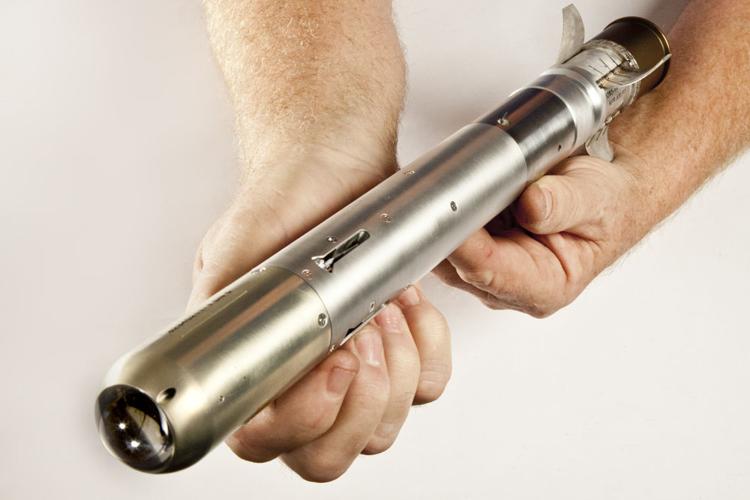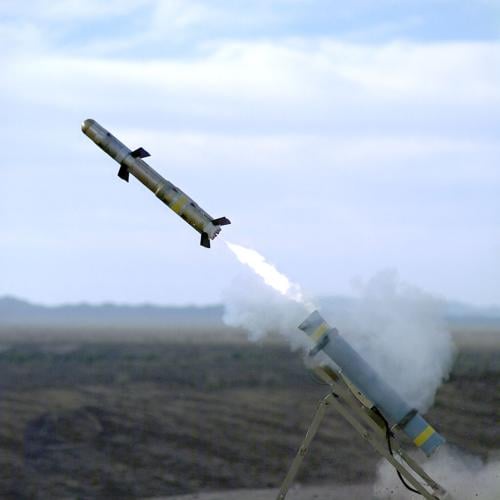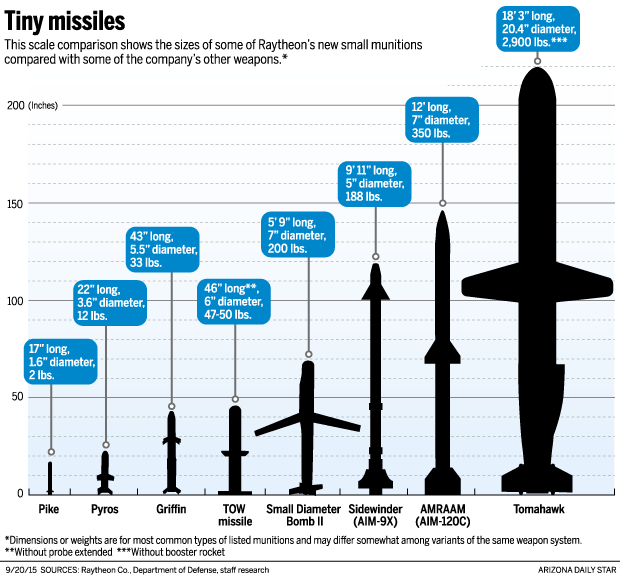They’re not shooting precision-guided bullets — yet.
But Raytheon may be the closest yet, with a tiny guided missile a soldier can launch from a rifle-mounted grenade launcher.
Meet the Pike, a 17-inch-long, laser-guided munition that Tucson-based Raytheon Missile Systems is developing on its own dime in hopes the U.S. Army and perhaps other allied armies will buy it.
The Pike and other small guided munitions Raytheon has developed in recent years meet a growing demand for precision, targeted strikes that leave minimal “collateral damage” — death or injury to civilians and property damage — in an era where enemies often hide in crowded areas.
“Nowadays we’re not worried nearly as much, about mass formations of an adversary’s armor,” said J.R. Smith, Raytheon’s director of advanced land-warfare systems. “A lot of it now is insurgents, and they’re in light vehicles or you’ve got people planting IEDs (improvised explosive devices).
“You want something very precise, you want to have very measured effects with your warhead.”
Raytheon already has had success with its 3ƒ-foot Griffin missile, which it initially developed on its own and started producing in 2008.
The company has delivered more than 2,000 Griffins to the U.S. Special Operations Command, which mounts the missile aboard its AC-130 fixed wing gunships. The Griffin, the smallest Raytheon missile in production, is now operational on naval patrol boats and can be carried by drones such as the MQ-1 Predator.
Other small munitions Raytheon is developing include the Pyros, a roughly 2-foot guided bomb that is being test-launched from small unmanned aircraft; and the Precision Extended Range Munition (PERM), a guided 120-millimeter mortar round in development for the Marine Corps.
TINY AND TOUGH
Raytheon has long produced some smaller weapons, like the 2.75-inch diameter Talon guided rocket. But packing sophisticated guidance and control electronics into something as small as the Pike and Pyros is no mean feat.
The Griffin was developed with sensor technologies borrowed from other Raytheon weapons, including the venerable Sidewinder air-to-air missile and the Raytheon-Lockheed Martin Javelin anti-tank missile.
Raytheon didn’t have the same options with the Pike, which required more ground-up design to reach a new level of miniaturization. With an air-to-air missile, for example, guidance electronics are fitted in a roughly 2-foot section of tube about 5 to 7 inches in diameter, Smith said.
Advances in circuit miniaturization helped Raytheon fit similar capabilities into the tiny Pike, which is just 1.6 inches in diameter.
“Now, you can do the same thing and actually get something more powerful in something that’s basically the size of a roll of quarters,” Smith said.
Another problem Raytheon needed to solve with the Pike and the PERM mortar munition is to make them “gun hardened,” or hardy enough to survive launch. The Pike is blown out of the grenade tube with a small charge before its rocket motor kicks in; the PERM relies on a single charge to propel it toward its target.
“You’ve go to make the things darn sturdy — they have to be able to withstand that shock and impact,” Smith said. “That’s something we’ve worked very hard at.”
Raytheon had already solved that problem on a larger scale with its Excalibur 155 mm precision-guided artillery round.
First fielded by the U.S. in 2007 and now used by several allies, the GPS-guided Excalibur can hit within a few meters of its target and has been fired more than 700 times in combat. Raytheon is working to add laser guidance and plans to test a narrower version for 5-inch Navy guns later this year.
The shock solution was to encase its electronics in a putty-like material.
“They’re actually potted in material — it looks like little mini-hockey pucks, embedded in material that keeps it in place,” Smith said.
Miniaturized guided weapons — including rockets, artillery, GPS-guided mortars, radar-seeking and anti-armor weapons — are likely to become a major part of ground warfare. Raytheon cites a recent speech by U.S. Deputy Defense Secretary Bob Work at the U.S. Army War College in Pennsylvania.
“We’re not too far away from guided .50-caliber rounds,” Work said.
He’s right: The Defense Advanced Research Projects Agency, or DARPA, began test-firing a laser-guided, .50-caliber bullet last year.
PITCHING THE PIKE
While the Pyros had some development funding from an undisclosed U.S. armed service, Smith said the Pike so far has been developed in-house by Raytheon with the expectation the U.S. or other allied militaries will be interested.
The company plans to pitch the Pike to the Army and representatives of allied nations next month at the Association of the U.S. Army annual meeting in Washington, D.C.
Raytheon and other defense contractors spend billions of dollars on in-house development of new weapon systems, essentially gambling that they will be picked up for military funding and use. Companywide in 2014, Raytheon Co. reported spending $500 million — or about 2 percent of revenues — on in-house research and development.
Smith declined to disclose what Raytheon has spent on Pike development.
“I wouldn’t call it a gamble,” he said. “If you want to show leadership in this industry, you’ve got to put yourself out there and anticipate what the customer, what the warfighter, needs and be able to provide it.”
Raytheon sees a large market for the Pike, which can be fired from common 40mm grenade launchers — including the rifle-mounted M203 launcher — and directed to the target with a portable laser designator.
“If Pike were to take off and really be something that the Army and the Marine Corps thought they needed, you’re talking about programs of record where they’ll want 60-70,000 of those things,” Smith said.
SAFEGUARDING TECHNOLOGY
Not everyone thinks a proliferation of tiny guided munitions would be a good thing.
Daryl Kimball, executive director of the nonprofit Arms Control Association, said he worries that our enemies could get ahold of these smaller guided weapons.
“You have to be careful that the technology does not fall into the hands of adversaries or other irresponsible actors,” Kimball said. “That’s been the case with a number of different conventional arms technologies through the years.”
He cited the U.S. Stinger missiles and foreign made “MANPADS” — Man Portable Air Defense Systems — which were widely used in the Soviet-Afghan War and have shown up in the hands of some militant groups in the Middle East and Africa. More recently, TOW anti-tank missiles reportedly were used by Islamic State militants.
Kimball says his group also is concerned about the threat of armed, unmanned aircraft being used by enemy states and non-state militant groups. The U.S. combat drone program itself has come under attack over reported civilian casualties and the secrecy that shrouds details of the program.
The U.S. government earlier this year said it had developed a set of classified guidelines for transference of armed-drone technology, which so far has been shared only with the United Kingdom. The U.S. is finalizing a proposed sale of unarmed reconnaissance drones to the United Arab Emirates, a key Middle East ally.
“The question we need to ask ourselves is, do we as a nation need to pursue limits and controls on certain kinds of armed UAV (unmanned aerial vehicle) technologies so we don’t have dangerous and unstable situations facing ourselves and our troops abroad?” Kimball asked.
Raytheon’s Smith said any arms sales would have to comply with the International Traffic in Arms Regulations and related laws, and must ultimately be approved by the U.S. government.
He said Raytheon has seen strong international interest in the Pike and Pyros but he would not disclose the interested nations.
Much of the small-missile development work is performed in Tucson, Smith said.
Raytheon is Southern Arizona’s largest private employer and one of the state’s biggest tech companies, with more than 9,000 local full-time workers.
The Pike program manager at Raytheon Missile Systems is Frank Antenori, a combat veteran of the U.S. Army Special Forces and a former Arizona state legislator.







